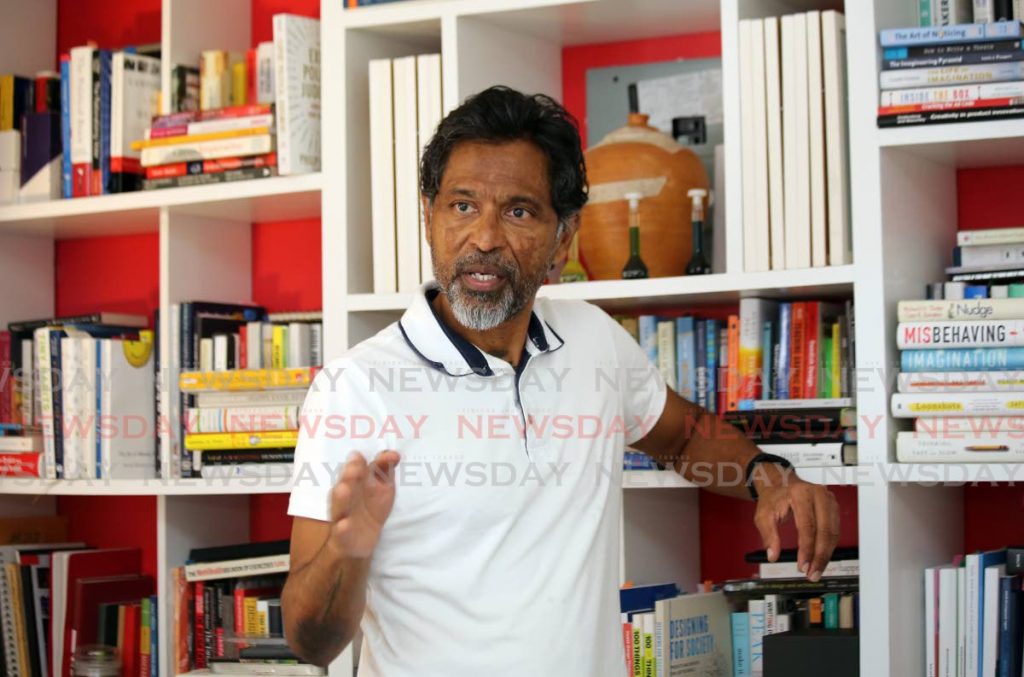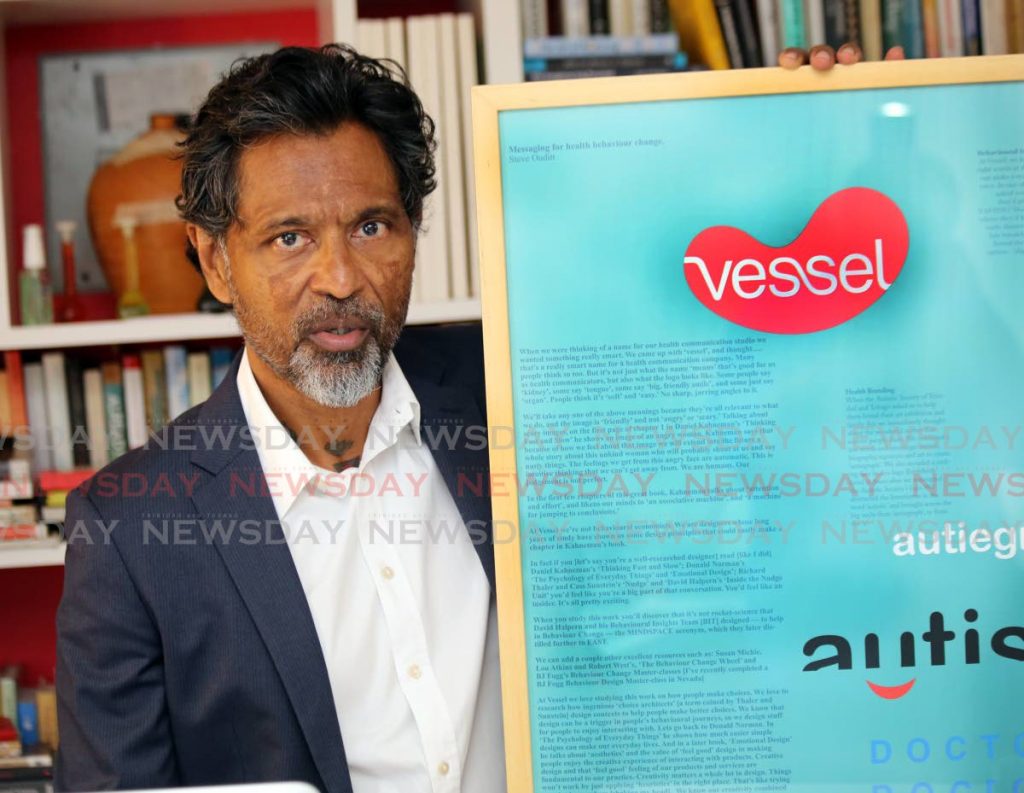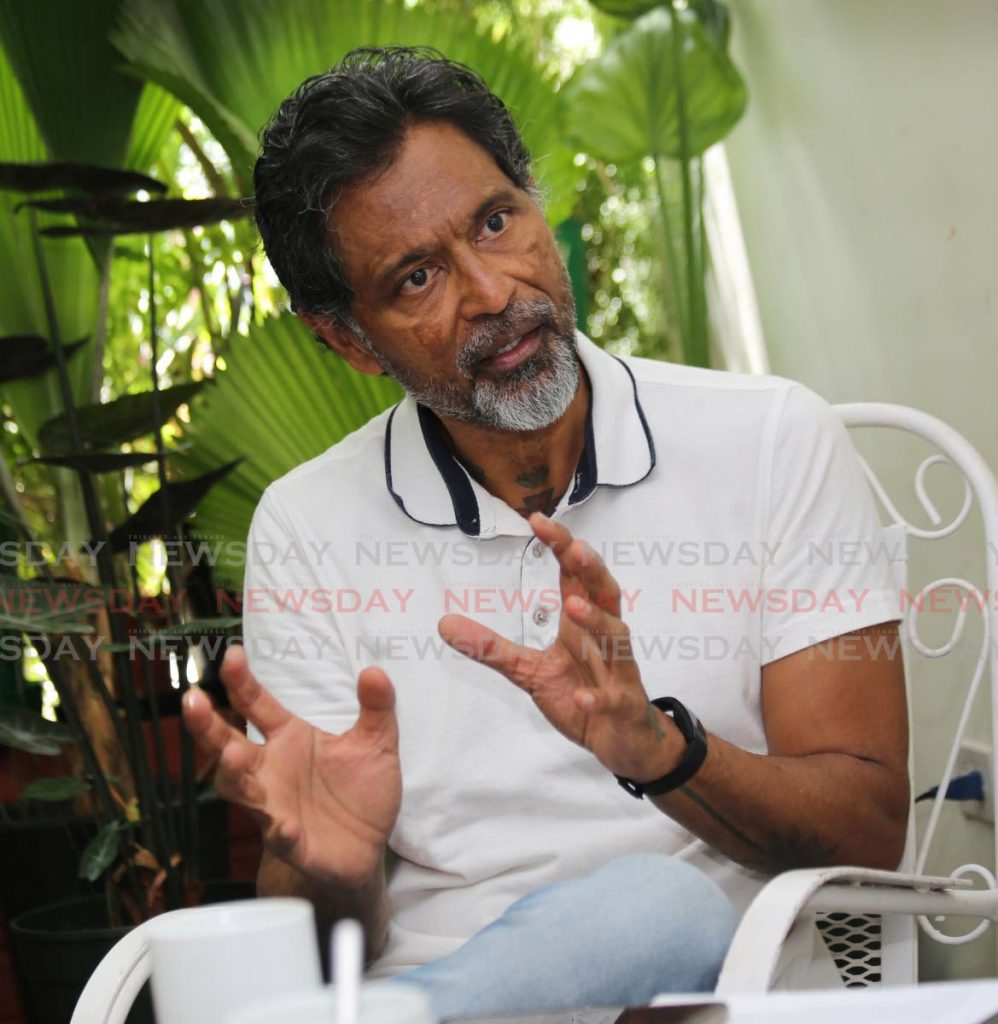Steve Ouditt explores art, design to change behaviour

Human-centred and user-centred design have been at the forefront of designer and lecturer Steve Ouditt’s study and practice for many years.
What that means is evident on entering his flat in St Ann’s. From the mini-gallery to the carefully arranged mini-garden and cleverly designed exercise area to the tap-to-open kitchen drawers, the space is designed with the user in mind.
It is this love for design, how it applies to everyday life, and his work with the Caribbean Behaviour Change Network (CBCN) which he says contributed to his appointment as the first senior art lecturer in the history of UWI, in August 2020.
Ouditt has been an artist for over 30 years, beginning when he attended Fatima College, where he dropped out in sixth form. He worked in various jobs, including DEWD (an early precursor to CEPEP); as a supermarket cashier; and painted books, T-shirts, sneakers, bags, etc.
“I got encouragement from the people around me. While my father was disappointed, he didn’t curse me. He didn’t try to steer me away from art, so I don’t have the horror stories that a lot of other young artists do. He did introduce me to my first love, books, when he took me to the library. I now have over 3,000 books in storage.”
He went to the School of Visual Arts in New York, where he studied media art, sculpture and installation and got a distinction. He lived in New York for ten
years before returning to Trinidad, where he began teaching at UWI Extra-Mural, the precursor to UWI Open Campus, with fellow artist Eddie Bowen.
“The artists at the time were kind and let us learn from them. People like Carlisle Chang, Carlise Harris, Leroy Clarke. We went around to the artists and they supported us. We never announced we were coming to take things over, we knew the history of the people who had gone before us.”
Next, Ouditt did an MA in the history and theory of art at Goldsmiths College, University of London. That's where he developed his fundamental approach.
“My undergrad training focused on what my professors called constructive design, what is now known as user-centred or human-centred design, how to make things user-friendly.

"I was interested in looking at how colonisers created images of people and their spaces in colonies and how colonised people would reflect on those spaces, things and objects. I later did a project with approval of one of my heroes, Lloyd Best, called Plantation Economy and Trademark Capital, which asked what would it look like if there was a period during colonialism when all these organisations were branded, what would have been the brand story, and if the colonised were looking at them, how they would have related to them? I created a set of logos for all sorts of industries and imagined what they would have done during the period of colonisation.
"Throughout my life, the idea behind the work has always been how people used the images, things, spaces, objects, services, because that project had a lot to do also with how did the colonisers make things user-friendly, or did they care to, and for which users? Or was the user-friendliness a result of this hardcore power?”
While at Goldsmiths, Ouditt wrote for various magazines. He returned to Trinidad but could not get a permanent job with an arts degree. His friend architect Mark Raymond shared his articles at the Caribbean School of Architecture in Jamaica, and Ouditt was offered a job teaching architects about what space means to people, how people behave in spaces and how they design and use objects for different purposes.
Ouditt stayed in Jamaica for two years, then got a research fellowship at the Jan van Eyck Academy in Maastricht, Holland. He returned briefly to TT before moving to London as the curator of research at the Institute of International Visual Arts.
“Their remit was to work with stakeholders not represented in British mainstream art culture, so they attracted a lot of black and minority ethnic (BAME) writers, artists and scholars. I worked with and developed programmes for many kids of migrants."
Then Ouditt applied for the job of lecturer at UWI, where he has remained for the last 17 years. He has used his ethos to teach undergraduate students about design and how it works in society.
Ouditt has exhibited consistently over the years, beginning in the 1980s, when he worked with the Baggasse (theatre) Company, designing posters for some of their first shows, and with the New York carnival to design Caribbean Baroque costumes with Peter Minshall. He assisted in developing Crossover Design, TT's first ever cross-disciplinary arts studio, with Bowen and current CBCN partner, psychiatrist Prof Gerard Hutchinson; exhibited at Carifesta V in 1992; and helped design 3canal's 1994 band Jocks Tuh Pose.
He has shown mixed-media work in London which spoke to his experience as an immigrant. His exhibition in Iceland in 2006 showcased artists concerned with examining post-colonialism. His work and publications in the US, Canada and Jamaica from 2000-2010 centred on spatial design and artistry in the Caribbean.

His 2013 exhibition Proceeds to Mental Health, at the Medulla Gallery in Port of Spain, used art to explore various emotions associated with mental health. He said it was at that time he decided to make the shift to exploring behaviour-change interventions in healthcare.
"A lot of designers for social change see pedagogy as an active practice, they see working as a very active practice. My work is not a practice that finds itself on gallery walls. (It) deals with vets and their animals, young people with autism, pregnant women who are diabetic – that is where that sort of user-centred, human-centred design thing has coalesced from since I was a younger person."
His work focuses on what scientists call context-driven behaviour change, in contrast to information-driven behaviour change.
“In the information model, you give people information and hope they will change the behaviour that is bad for them. Researchers have said this doesn’t work, but what does work is putting the behaviour in context and making it harder to achieve so people find it easier to change.”
His newest venture is the CBCN, established in collaboration with the Arthur Lok Jack School of Business, Ogilvy BSP London and Vessel Health Communication. Ouditt has been able to implement his model in several projects he has carried out since forming his company in 2016.
“The first project we did was with Dr Paul Teelucksingh, working around diabetes in pregnant women. Normally they’d be asked to do a fasting blood test, but we changed the language to ask them to have a slightly earlier dinner and slightly later breakfast. This helped the women to incorporate the fasting period into their schedules.
"We also did a Doctor Donor project to encourage people to donate, as it suggested that since they trusted their doctors, they could trust the donation process.
"Another great project was the development of the Autiegraph, combining the concepts of photographs, autographs, autism, and biography to help autistic people to share their stories in a way that others could understand easily.”
For more information on the Caribbean Behaviour Change Network, visit https://lokjackgsb.edu.tt/cbcn/ and for Vessel Health Communications, visit https://vesseltt.wixsite.com/


Comments
"Steve Ouditt explores art, design to change behaviour"